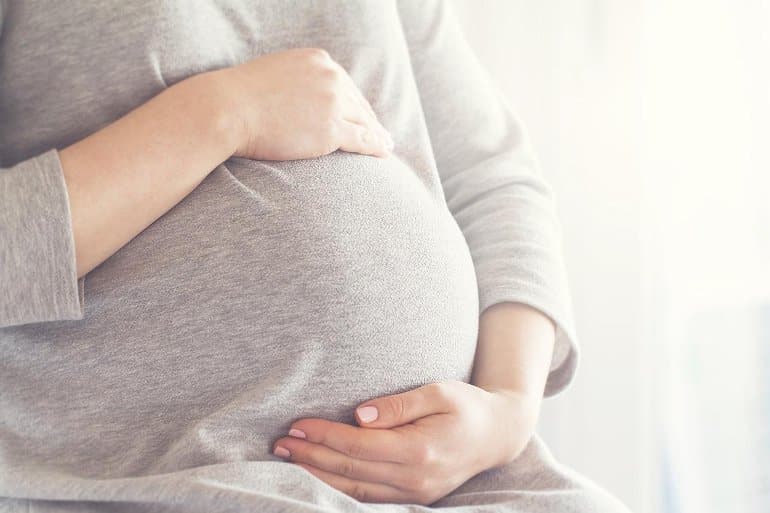Summary: Researchers found no association between in vitro exposure to SSRI antidepressants and an increased risk of a child developing depression.
Source: WUSTL
In one of the first studies to look at the association between selective serotonin reuptake inhibitors (SSRI) medications and brain development in young children, research from the Behavioral Research and Imaging Neurogenetics (BRAIN)Lab at Washington University in St. Louis found no association between children’s exposure to the drugs in the womb and later childhood depression.
The study is in press in the journal Biological Psychiatry Global Open Science.
For the investigation, author Allison Moreau, a Ph.D. student in the BRAIN Lab run by Ryan Bogdan, associate professor of psychological & brain sciences in Arts & Sciences, analyzed a sample of more than 10,000 children from the largest long-term study of brain development in the United States, the Adolescent Brain Cognitive Development (ABCD) Study.
Initially, they observed among children prenatally exposed to SSRIs a small increase in depression that was independent of family history of depression and child polygenic risk for depression. However, they found that this association was no longer significant once they subtracted from their analysis the known effect of maternal depression on a child.
“We found prenatal SSRI exposure is not associated with increased depression, after accounting for the mother’s current depression,” Moreau said.
SSRIs are a class of medications often prescribed to treat depression, but they are also used as treatment for other illnesses, such as obsessive-compulsive disorder and anxiety.
In addition to behavioral outcomes, the researchers also looked at the children’s brain structures to determine whether there might be any associations between prenatal SSRI exposure and any changes in the children’s developing brains. There, the data did reveal a difference between children who were and were not exposed in the womb to SSRIs, but it was not related to children’s depression.
Children who were exposed had a slightly thicker left lateral occipital cortex and a slightly larger surface area of the left superior parietal cortex than children who weren’t.
“Notably, the observed brain differences were small, and they were also unrelated to depression,” Moreau said. “It’s unclear if these small differences have any meaningful consequence.”
In the meantime, Moreau says the findings can be used to facilitate a conversation when it comes to clinical care and pregnancy. About 5.5 percent of pregnant people take SSRIs; 11 percent do so during their reproductive years.
“Overall, these data suggest that SSRI use during pregnancy is not independently associated with elevated depression during middle childhood (~10 years of age),” Moreau said.

“The data suggest that maternal depression, not the use of SSRIs, is more related to childhood depression. That’s an important factor to keep in mind in discussions of pregnancy and mental health.”
However, this study does not resolve this question. The researchers will have the opportunity to look at these children as they grow older as the ABCD study will follow them into young adulthood. The ability to be able to return to these children and capture more data is particularly important as the average age of depression onset is 19.
Indeed, Bogdan said, “Many may feel between a rock and hard place when facing medical decisions, especially during pregnancy—these data suggest that risk for depression during middle childhood associated with prenatal SSRI exposure should not discourage SSRI use.”
However, he said, “Science is always evolving and more data are needed—our study evaluated depression in children from about 9 to 10 years old. It is really important to address this question in this dataset as children continue to develop and enter peak periods of vulnerability. It is possible that we observed no independent risk because the peak window of depression vulnerability has not yet occurred.”
About this neurodevelopment and depression research news
Author: Brandie Jefferson
Source: WUSTL
Contact: Brandie Jefferson – WUSTL
Image: The image is in the public domain
Original Research: Open access.
“Prenatal Selective Serotonin Reuptake Inhibitor Exposure, Depression, and Brain Morphology in Middle Childhood: Results From the ABCD Study” by Allison L. Moreau et al. Biological Psychiatry Global Open Science
Abstract
Prenatal Selective Serotonin Reuptake Inhibitor Exposure, Depression, and Brain Morphology in Middle Childhood: Results From the ABCD Study
Background
Prenatal selective serotonin reuptake inhibitor (SSRI) exposure has been inconsistently linked to depression, and little is known about neural correlates. We examined whether prenatal SSRI exposure is associated with depressive symptoms and brain structure during middle childhood.
Methods
Prenatal SSRI exposure (retrospective caregiver report), depressive symptoms (caregiver-reported Child Behavior Checklist), and brain structure (magnetic resonance imaging–derived subcortical volume; cortical thickness and surface area) were assessed in children (analytic ns = 5420–7528; 235 with prenatal SSRI exposure; 9–10 years of age) who completed the baseline Adolescent Brain Cognitive Development Study session. Linear mixed-effects models nested data. Covariates included familial, pregnancy, and child variables. Matrix spectral decomposition adjusted for multiple testing.
Results
Prenatal SSRI exposure was not independently associated with depression after accounting for recent maternal depressive symptoms. Prenatal SSRI exposure was associated with greater left superior parietal surface area (b = 145.3 mm2, p = .00038) and lateral occipital cortical thickness (b = 0.0272 mm, p = .0000079); neither was associated with child depressive symptoms. Child depression was associated with smaller global brain structure.
Conclusions
Our findings, combined with adverse outcomes of exposure to maternal depression and the utility of SSRIs for treating depression, suggest that risk for depression during middle childhood should not discourage SSRI use during pregnancy. Associations between prenatal SSRI exposure and brain structure were small in magnitude and not associated with depression. It will be important for future work to examine associations between prenatal SSRI exposure and depression through young adulthood, when risk for depression increases.






